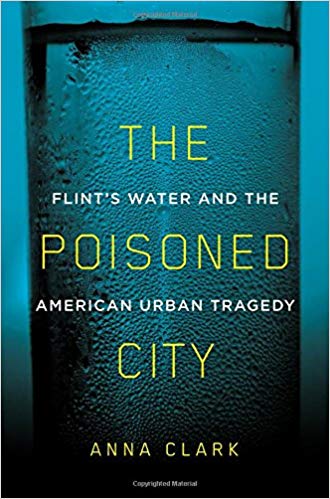The Poisoned City, by Anna Clark
Jul 30
2018

As longtime readers of the site know, every once in a while we review nonfiction books on subjects that we consider to be of general interest: money, food, education, the environment. Our latest pick is Detroit journalist Anna Clark's The Poisoned City, a convincing and devastating look at the water crisis in Flint, Michigan.
The Poisoned City: Flint's Water and the American Urban Tragedy explores the perfect storm of systemic racism, disintegrating infrastructure, and short-sighted policy decisions that lead to Flint residents being poisoned with lead. In an effort to cut costs, Michigan decided to remove Flint from the Detroit water system. While the city waited for a new system to be built, it began drawing water from the Flint River in 2014. There were concerns about the historically polluted river, but the real danger came from an unexpected source: the new water corroded Flint's aging pipes, delivering lead (along with E. coli and other bacteria) to homes throughout the city. Over the next eighteen months, residents became activists as their concerns about the water grew, even as government officials insisted nothing was wrong.
If you skip the lengthy notes section, The Poisoned City is only a little over 200 pages long, and Clark presents her material in a straightforward, easily digestible style. (I had to look up a few scientific terms, but it was nothing like The Cadillac Desert, which I read with a dictionary right by my side.) I was worried I would find the book too grim to finish—and it is most definitely grim—but the author's description of the Flint residents' organized, determined response to the crisis counterbalances some of the darkest material. Obviously this isn't going to be everybody's ideal summer beach read, but anyone looking for an informative and engrossing guide to this still-unfolding disaster need look no further.
The Poisoned City: Flint's Water and the American Urban Tragedy explores the perfect storm of systemic racism, disintegrating infrastructure, and short-sighted policy decisions that lead to Flint residents being poisoned with lead. In an effort to cut costs, Michigan decided to remove Flint from the Detroit water system. While the city waited for a new system to be built, it began drawing water from the Flint River in 2014. There were concerns about the historically polluted river, but the real danger came from an unexpected source: the new water corroded Flint's aging pipes, delivering lead (along with E. coli and other bacteria) to homes throughout the city. Over the next eighteen months, residents became activists as their concerns about the water grew, even as government officials insisted nothing was wrong.
If you skip the lengthy notes section, The Poisoned City is only a little over 200 pages long, and Clark presents her material in a straightforward, easily digestible style. (I had to look up a few scientific terms, but it was nothing like The Cadillac Desert, which I read with a dictionary right by my side.) I was worried I would find the book too grim to finish—and it is most definitely grim—but the author's description of the Flint residents' organized, determined response to the crisis counterbalances some of the darkest material. Obviously this isn't going to be everybody's ideal summer beach read, but anyone looking for an informative and engrossing guide to this still-unfolding disaster need look no further.
Posted by: Julianka
No new comments are allowed on this post.
Comments
No comments yet. Be the first!